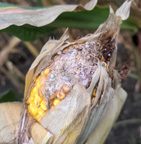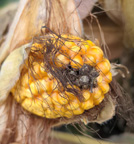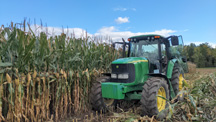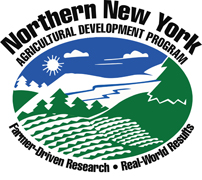
 Photos: Visual difference between corn damaged by Western bean cutworm and corn protected by VIP3A endotoxin. Photos: Allen Wilder/Miner Institute
Photos: Visual difference between corn damaged by Western bean cutworm and corn protected by VIP3A endotoxin. Photos: Allen Wilder/Miner Institute
Chazy, New York; June 28, 2023. The Northern New York Agricultural Development Program (NNYADP) has announced the results of research investigating the impact of Western bean cutworm (WBC) damage on the nutritional quality of corn silage. This is little existing research about this correlation.
WBC moths begin laying their eggs on corn crops in northern New York in July. The populations of this moth, first discovered in New York State in 2009, have grown exponentially across the state. While this pest is known to cause significant economic and quality losses in field corn grain, less research has been conducted on its impact on corn silage.
With a small grant from the farmer-driven NNYADP, Allen Wilder, a forage agronomist with the W.H. Miner Agricultural Research Institute, Chazy, New York, compared silage yield and 25 quality metrics of corn silage made from two corn hybrids that differed only by their genetic insect damage-protection traits. One hybrid included VIP3A endotoxin to resist WBC damage; one did not.
“Few controlled studies have been done under northern New York conditions to examine how damage done by Western bean cutworm impacts the aerobic stability of corn silage that in turn influences the forage quality of the silage fed to dairy cows here,” Wilder said.
 Western bean cutworm pressure was high during the trial with more than half of the WBC-susceptible plants showing signs of infestation in the ear tips of the corn. The hybrid with the VIP3A endotoxin showed negligible feeding by WBC larvae.
Western bean cutworm pressure was high during the trial with more than half of the WBC-susceptible plants showing signs of infestation in the ear tips of the corn. The hybrid with the VIP3A endotoxin showed negligible feeding by WBC larvae.
Ear tip feeding by WBC may result in higher populations of undesirable microorganisms, such as yeasts, in silage. The damaged corn in this trial showed dramatically higher levels of mold colony-forming units. The higher yeast count in the damaged corn may have influenced the data showing a significantly longer duration of heat development in the ensiled corn.
Wilder notes that although aerobic stability differences were not noticeable in this single trial, palatability differences may impact cow performance.
WBC damage also resulted in a yield difference between the two corn hybrids.
“The damaged corn in this trial measured lower yield of almost two tons less of as-fed silage per acre,” Wilder said.
Wilder’s complete project report is posted at www.nnyagdev.org under About: NNYADP Projects by Year: 2022.
Growers interested in tracking when and where various pests, including Western bean cutworm, appear in New York State can follow the Weekly Field Crops Pest Report updates by Cornell University IPM Field Crops and Livestock Coordinator Kenneth Wise at https://blogs.cornell.edu/ipmwpr/ .WBC reporting is expected to post from July to mid-August.
Wise notes, “If the flight of the Western bean cutworm is timed with pre-tasseled corn, growers should look for WBC eggs on corn leaves.”
 Funding for the Northern New York Agricultural Development Program is supported by the New York State Legislature through the New York State Assembly and administrated by the New York State Department of Agriculture and Markets.
Funding for the Northern New York Agricultural Development Program is supported by the New York State Legislature through the New York State Assembly and administrated by the New York State Department of Agriculture and Markets.